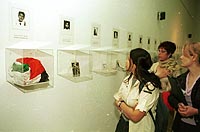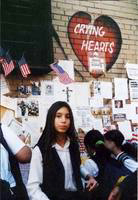
Open through May 17,
10am-7pm
Unesco Palace, Beirut
100 Shaheed
100 Lives
Honoring the shaheed raises many questions
Are all intifada victims martyrs?
Samar Kanafani
Daily Star Lebanon staff
An exhibit dedicated
to the first 100 Palestinians to perish in the intifada struck the emotional
chords of spectators, but the objects on display and the attribution of
martyrdom to all who die in the Occupied Territories left some questions
unanswered.
The 100 Shaheed
100 Lives exhibit, whose popularity has snowballed since it was assembled
in Ramallah in February 2001, attempted to restore humanity to the innocent
people who were “martyred” by Israeli attacks.
According to Adila
Laidi, director of the Khalil Sakakini Cultural Center in Ramallah and
the exhibition’s organizer, the aim was to celebrate the genuine
lives of all “martyrs” of the intifada, untangling them from
the trappings of heroic glamor.
Thus a black-and-white photograph and the name tag of each victim is hung on the wall above one of their belongings, which is placed in a plexiglass encasement, in a set-up that strongly resembles the reliquaries where sacred relics are kept.
Laidi said that she
and the exhibit’s artist, Samir Salameh, opted for a “minimalist”
and “clean” format in order to direct people’s focus on
“the story” and to “avoid making a show of these martyrs.”
However, the effort
to conjure up the lives of these unfortunate victims and render them tangible
and accessible to the average viewer was somewhat mired by the religious
and sacred symbolism used in the exhibit’s presentation.
Resembling small shrines,
with the pictures placed above the average viewer’s eye level, the
experience fell short of bringing this reporter closer to the lives of
the depicted people.
Presumably, displaying objects that the victims possessed, liked or regularly handled draws attention to their attachments, offering a glimpse of their physical presence and everyday life. But the exhibit and its accompanying booklet, which contains brief highlights of the victims’ background and life, left one asking what significance these objects had to their owners.
The circumstances
of the violence in Palestine may have made it difficult for the exhibition
organizers to extract more vivid stories from these objects and the manner
in which their owners used them, but this would have helped demystify
the display.
What did a power drill
mean to 26-year old Iyad Lawabneh from Nazareth, who was shot by Israeli
snipers on Oct. 2, 2000? How often did 19-year-old Mahmoud Iseid from
a village outside Jerusalem, who was killed on Nov. 3, 2000, tend to the
birds in his displayed birdcage?
But in some instances the items displayed worked well, like in the showing of the soccer balls of teenager Sami Taramsi who loved to play soccer with his friends, as well as the “favorite headscarf” of 58-year-old Aziza Dannoun, who is one of only three women among the 100 shuhada.
Laidi hoped to bring
these people to life as well through the use of everyday shots and passport
pictures living images as opposed to showing them pictured
as corpses, which often appears in the media.
“This is a reaction
to the violent (television) footage, and which I find exploitative,”
she told The Daily Star.
Yet, to a certain degree, the persistent use of the word shaheed to categorize
all people who lose their life in the struggle against Israeli occupation
seemed to efface individuality and ultimately their humanity.
The exhibit places
11-year-old Mohammed Dura who was killed while walking home with
his father and Louay Muqayyad who was shot dead while attempting
to avenge the death of another Palestinian under the single heading
of “shaheed.”
True, all 100 people and thousands of others were killed after they endured Israel’s illegal occupation and its sweeping military offensive, but to call each one a “shaheed” is to enlist them in willful self-sacrifice, which they themselves did not chose.

http://www.911digitalarchive.org
The New-York Historical Society, in collaboration with City Lore: The New York Center for Urban Folk Culture, is pleased to announce the opening of the third exhibition in its History Responds series:
MISSING: Streetscape
of a City in Mourning
March 12 - June 9, 2002
Since the September 11 attack, City Lore has chronicled the public's attempts to come to terms with the World Trade Center tragedy, through photography, audio and video recordings, and the collection of related artifacts, such as found poems and elements of spontaneous shrines. In the immediate wake of the disaster New Yorkers transformed public spaces such as Union Square, the Armory, and the fronts of firehouses into such shrines -- places where singly and jointly, people could go to mourn, ask for help, bear witness, show support and offer testimony. With special emergency funding from the National Endowment for the Humanities, City Lore has taken the initiative in documenting as much of it as humanly possible. A pilot version of the current exhibition focusing on photographs of the spontaneous shrines by Martha Cooper was shown at the Municipal Art Society from October 19 through November 30, 2001.
Missing: Streetscape
of a City in Mourning illustrates how New Yorkers -- drawing on their
powers of expression, their words and symbols -- were able to forge a
creative response to the tragedy of a magnitude commensurate with the
loss. In striking images, in items left at Union Square, and in .personal
memorials and shrines from all five boroughs, the streetscape of public
grief that followed September 11th was unprecedented in American history
in its dispersion across the great New York area. New Yorkers showed an
amazing instinct and ability to use public spaces all over the city to
gather and express themselves, and, in many cases, to give others an opportunity
to do the same. Missing is a tribute to this great city where, despite
all its potential for anonymity and alienation, people seemed able to
create places where humanity could re-stake its claim.